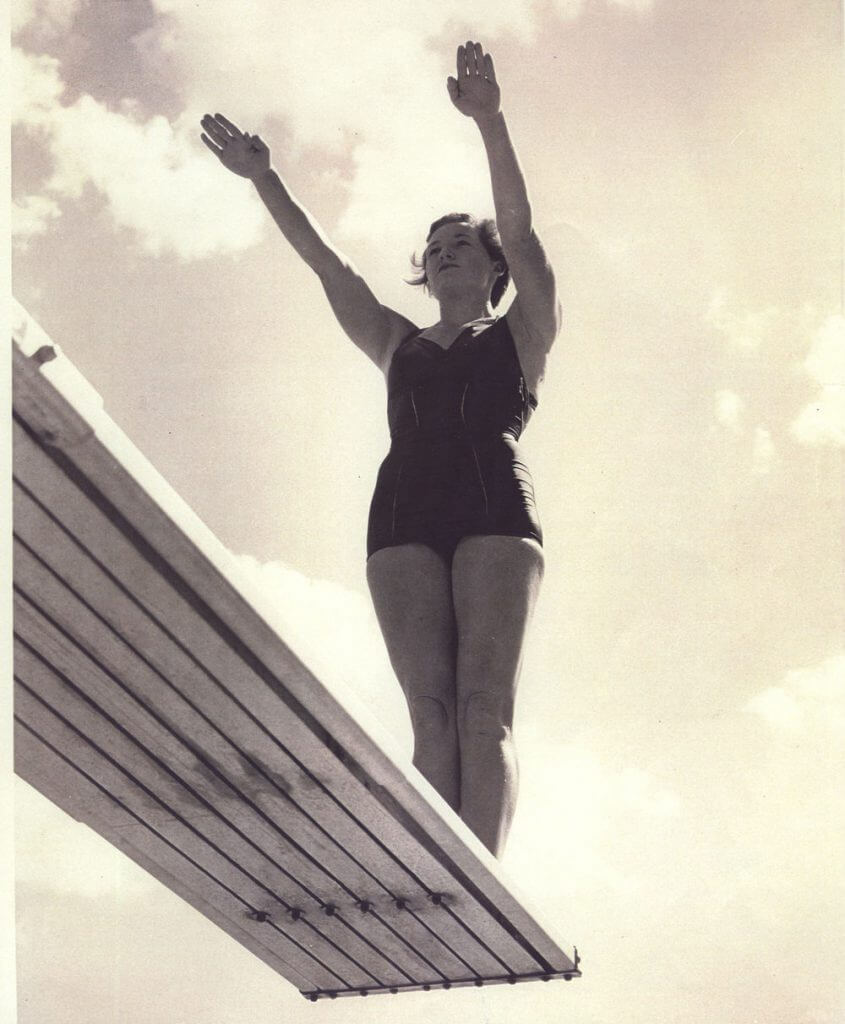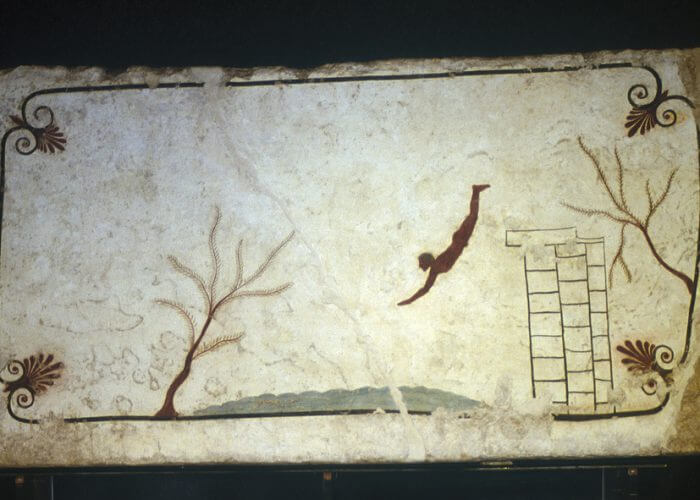Uncovering The Ancient Origins of Diving Boards

By Erin Keaveny, Swimming World Contributor
All divers, and most swimmers, have an image in their head of what a diving board looks like. The rough, turquoise-surfaced metal planks that sit on top of stands at the far end of the pool.
That diving board in your head, whether you know it or not, is more than likely a Duraflex Maxiflex Model B.
It’s the official board of FINA, USA and NCAA diving, and a staple of competition at every level. In fact, it has been the only board used in major competition since 1960.
The boards are designed to optimize a divers hurdle. They’re standardized so divers can practice and compete in the same way, no matter what pool they are at.
It wasn’t always this way. The modern diving board is a recent development in the sport’s history. While the sport made it’s Olympic debut in 1904, it dates back much farther than that.
The oldest documentation of diving is from a tomb dating back to the ancient Greeks. Although this is the earliest documentation, it’s safe to say thrill seekers have been jumping off things into water since the beginning of human history.
While the diving has ancient origins, there’s not much out there about the humble beginnings of the diving board.
The first places people dove from were more than likely cliffs and rocks. Those who dove off them came long before diving was organized sport. They dove because it’s freeing, thrilling, and simply fun.
Fast forward to the 18th and 19th centuries, German gymnastics would practice tumbling skills by flipping off of bridges into the water below in summer months. Swedish gymnasts would do the same, but they built wooden scaffolding at lakes and beaches for their purposes. This is widely accepted as the origins of diving, and man made diving platforms.
This was far from the beginning.
Fascinatingly, the the finest surviving example of fifth-century Greek wall painting is The Tomb of the Diver, which has been dated to around 470 B.C.E. It is also the only tomb from the time period in which the frescos portray human subjects.

Photo Courtesy: Tyler Bell, https://www.flickr.com/photos/tylerbell/4099004289
Scholars have studied the piece as an early fresco, and deathway art piece. The diver, is said to represent the passage of life to death. Yet, this ancient fresco also presents an interesting insight to the history of the diving board.
As art imitates life, the unknown artist of this fresco was more than likely familiar with diving. Further, the man depicted is diving off of a kind of man made scaffolding. This suggests that scaffolding was built for recreational diving far before the 18th century, and that diving off of man made structures has ancient roots.
It makes sense that diving boards can be traced back to the ancient Greeks, the founders of organized sports. Competitive sports dates back to 776 B.C.E. when the first Olympic Games were held, featuring running and jumping, the earliest version of track and field.
The Greeks were masters of sports that challenged the capacity of the human body, and required little to no equipment. It is easy to see how the thrills and challenges of diving fit into the Greek’s idea of sport.
The only problem is that not every body of water is near a cliff large enough for diving. Therefore, at some point someone built a structure for the purpose of sport, and 300 years after the first Olympic Games, that type of structure was documented in the Tomb of the Diver.
As diving continued towards the modern age and developed into an organized sport, the boards developed as well.
At the first Olympic diving event in 1904, divers dove from a high board, a low board, and the side of the pool. It was not until the 1928 Olympics that the standard events became 10-meter platform, and 3-meter springboard. These springboards were typically made of wood. They were stiff, wobbly and not standardized.
By 1928 women were allowed to dive in the Olympics. Each country had their own way to build a diving board, and many of them were made of stiff aluminum beams. The design of the boards were clunky, and restricted divers’ performances. Additionally, competing away from home presented an additional challenge for divers who had to learn to dive off a different kind of board.
In the 1960 Rome Olympics, the first carefully engineered and highly scientific Duraflex board debuted. The board was designed by Ray Rude, a self-taught engineer, and has been used in major competition since. Rude would later become the first person who was not a coach or an athlete to be inducted into the International Swimming Hall of Fame.
Today, the boards retail for around $5,000. Then, a three-meter or one-meter stand is going to cost an additional $19,000 or $10,000, respectively.
They may be expensive, but unlike in a backyard pool, the boards are perfectly designed for modern diving at the Olympic level.
A Maxiflex Model B is made of a single piece of aircraft aluminum alloy 6070-T6, heat treated for a yield strength of 50,000 pounds per inch. It is 16 feet long, and weighs 185 pounds. The end of the board has exactly 189 perforations, for better grip and lower air resistance. The thickness of the board tapers from the center, thickest in the middle and thinest at the ends, increasing flexibility and strength.
Diving boards have come a long way since their humble beginnings. But, that’s expected of anything that dates back to the ancient Greeks.




